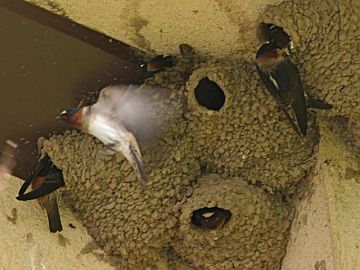 Last week I visited a cliff dwelling community where the homes are made of dried mud.
Last week I visited a cliff dwelling community where the homes are made of dried mud.
You might think I’d been to see the ancient Pueblo sites in the American southwest, but no. I went to Moraine State Park and watched the cliff swallows.
Quite common in the western U.S., cliff swallows are more localized in the east. They build their nests in colonies on bridges, buildings and cliffs. When you find them they are fascinating to watch, especially when the colony is under construction.
Cliff swallows build their nests one dab of mud at a time. Each bird flies back and forth from mud puddle to cliff carrying a tiny blob of mud to paste into place. They start the nest where a ceiling meets a wall, first making a cup then shaping it into a bowl then a gourd with a narrow opening that faces out and down. The nests often touch each other; one bird’s ceiling is another bird’s floor. It’s a wonder that the colony remains stuck in place.
In Chuck Tague’s photo the birds are busily building their nests, constantly arriving with mud and departing for more. At the mud puddles the swallows arrive in large numbers, holding their wings straight up and quivering them as they walk around collecting mud. Keeping their wings aloft probably allows them to take off easily without getting their wings muddy but it makes them look like oversized butterflies.
As the nest develops, one of the pair builds from inside. You can see a swallow inside two of the nests, the white patch on their foreheads shining out of the hole like a miner’s headlamp.
If you’d like to watch a colony, I know of three locations in western Pennsylvania: the Route 528 bridge over Lake Arthur at Moraine State Park, the Route 381 bridge over the Youghiogeny at Ohiopyle and the Fish Hatchery at Linesville.